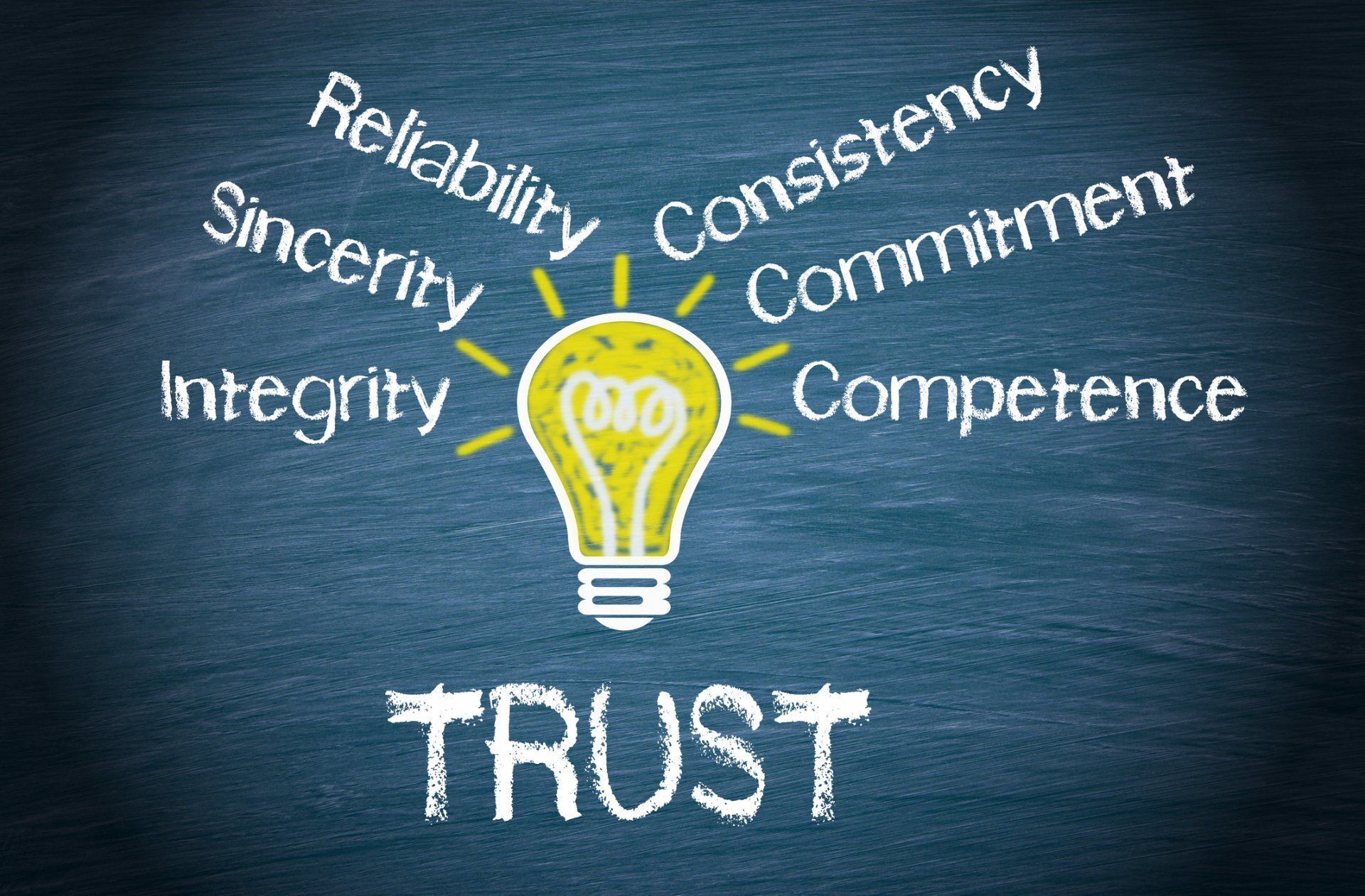Article
Developing Trust on Your Team
A Lack of Trust Can Destroy Your Team

What You Can Do To Develop an Atmosphere of Trust on Your Team
Trust is a central component of all healthy relationships. Teams are no exception. “There’s no team without trust,” said Paul Santagata, Head of Industry for Retail/Tech/Telecom at Google. “In Google’s fast-paced, highly demanding environment, our success hinges on the ability to take risks and be vulnerable in front of peers.” [“High-Performing Teams Need Psychological Safety. Here’s How to Create it” by Laura Delizonna, Harvard Business Review August 24, 2017]
The leader must facilitate trust and be a model of trust. This means creating a team environment characterized by open, candid relationships and a climate of psychological safety.
“As a company grows, communication becomes its biggest challenge. If the employees fundamentally trust the CEO, then communication will be vastly more efficient than if they don’t. . . A CEO’s ability to build this trust over time is often the difference between companies that execute well and companies that are chaotic.” – Ben Horowitz (quoted in https://www.zenefits.com/workest/ben-horowitz-culture-leadership-succeeding/)
It is a sad fact of my long experience working with entrepreneurs that many of them do not trust people easily, and this sets the tone for the way they manage their teams and how team members, in turn, manage their teams. When you don’t trust someone, if you feel they lack competence, skill, or experience or you question their good will and good intentions, you are more likely to try to control or micromanage them. This can severely damage a team’s effectiveness.
A lack of trust and a climate of fear on the team is the opposite of psychological safety. It is toxic and can result not merely in an uncomfortable workplace and a lack of openness, but also in finger-pointing and conflicts between team members, politics, false consensus leading to bad decisions, and ultimately in turnover. It will curtail collaboration, weaken problem solving, hamper individual and group performance and diminish results.
The more interdependent the team – the more team members are dependent on each other to get their work done – the more trust matters. This can be particularly relevant for startups where the number of people involved is small and collaboration is especially vital. For example, Engineers can’t build anything unless the Product team defines what customers want, what features they care about, and Product can’t really do that without coordination with the Marketing team. All these relationships rely on trust: that information is being openly shared, that people are telling the truth, giving honest feedback, working through differences and collaborating and working together to meet commitments.
When there is good will and psychological safety on a team, members will be willing to be vulnerable and openly discuss their problems, opinions, and concerns. In addition, trust also increases the commitment and loyalty between team members, which reduces unwanted turnover, and increases a sense of common identity.
How Trust Grows
Trust builds slowly, over time. It is built in very small moments but can be destroyed in an instant. If team members have shared important experiences and been successful working together, or have endured difficult times and made it through to the other side, trust will naturally increase.
Trust grows when there is openness, information sharing, honesty, and the ability to voice differences and work together through conflict. As Google’s Project Aristotle on effective teamwork has found, members must feel free enough to share their opinions without fear of recrimination or attack. As a New York Times article said, “ We must be able to talk about what is messy or sad, to have hard conversations with colleagues who are driving us crazy. We can’t be focused just on efficiency.”
Growth of trust also requires regular interaction between members, listening and respecting each other’s ideas. This too takes time, and it means that you, as the leader, need to look for opportunities to increase the level of interaction and collaboration between members of the team. If team members operate in silos or have more frequent communication with the leader than with each other, the team will be less effective.
This can be especially challenging with remote team members. Videoconferences between team members in another country or city, or just in another building or domain, have become commonplace and the leader must pay close attention to bringing team members together in person whenever possible. Where that is not an option, the leader needs to be very deliberate about insuring active participation from all team members rather than allowing in-person members to dominate the discussion.
Does Your Team Trust You?
Leaders are often unaware of how much – or how little – team members are on board with the leader’s strategy, goals, and plans. Even worse, they often assume they have the team’s trust, when that is not always the case. Here are some ways to tell if your team trusts you:
- Team members sometimes take a different view from yours, and express it freely.
- Team members keep you informed of their progress. They are comfortable coming to you for help or suggestions if they get stuck.
- Team members appear comfortable admitting mistakes, and are willing to discuss their problems rather than hiding or minimizing them, or concealing them in fancy PowerPoints.
- Team members approach you when they have a non-work problem, to request time off or support.
- Team members are not obviously defensive or over-critical about statements you make.
- Team meetings are relatively open and there is wide participation, with everyone making a contribution.
- Team members speak up – often privately – if they have a problem with one of your decisions or your behavior and are prepared to discuss their concerns.
- There does not appear to be excessive gossip in the team.
These are all signs that you have done a good job in creating an atmosphere of safety and trust.
What Happens When Trust Is Strong?
A recent meta-analysis of 112 research studies confirmed that trust between team members is highly correlated with the achievement of team goals. When trust is present, problem solving tends to be creative and productive. Discussions are livelier and out-of-the-box solutions get put on the table when fear of self-expression is absent. Members willingly take greater risks and say what is on their minds directly rather than behind others’ backs.
Trust has a similarly powerful impact on decision-making. The best decisions are made when the best thinking and all the facts are put on the table. When team members feel safe and expect that others will behave in a supportive and positive manner, they will be more willing to be vulnerable and open. They will work more collaboratively and stay more focused on team goals.
What Happens When Trust Is Weak?
When trust is not strong, people are unwilling to share their real opinions and concerns. In that case, you are not getting the best thinking out of them. Often this lack of trust is due to the leader, who may have created an intimidating environment or failed to police bad behavior among members, such as personal attacks. In that environment, people are unwilling to share intuitive insights or half-formed ideas.
Problem solving tends to degenerate and become ineffective. Interpersonal relationships among team members interfere with and distort perception of the problem. That’s because, in the absence of trust, people’s energy and creativity are more focused on self-protection than on finding creative solutions. They feel the need to protect themselves from attack, humiliation, or retribution, rather than apply their energy and attention to problem solving and may withhold half-formed ideas that may contain the seed of a solution.
In the absence of trust, team members are more suspicious of others’ motivations, and become defensive. Openness is reduced, and people don’t say what they really think. Team members lose sight of team goals and focus on personal self-interest.
How to Build Team Trust
- Be honest with team members. Don’t spin things. If you distort the truth or outright lie, team members won’t trust you. Tell them the truth rather than what you think they want to hear. A leader must establish and maintain high standards of personal integrity.
- Show team members that you care about them as people rather than merely as units of production. Organizations and teams are not machines. Results are important but excessive focus on hitting goals and deadlines or improving performance and quality can give the message that you only see team members as means to an end. Create opportunities to socialize with them in informal settings such as team dinners and avoid too much focus on business issues at that time.
- Be proactive in building relationships. Listen to individual team members and get to know them and their concerns. Check in with them regularly to find out how things are going in their world and how they are feeling about events, projects, problems etc. It is easy for a busy team leader to become isolated and insulated from the problems and concerns of employees. If you are too distant from team members and don’t invest in getting to know them and what is important to them, they will be less likely to trust you. Leaders who show interest in the needs and challenges of the employees they manage set a positive tone on the team. Employees who feel valued and supported are more likely to be motivated to get results.
- Occasionally survey the team to take its temperature, particularly around trust levels and morale. Then discuss any barriers to teamwork that are surfaced by the results.
- Don’t withhold information. Leaders often worry that openly sharing sensitive information about financial results, decisions, or developments could cause problems. Whenever possible, eliminate secrets. Provide team members with both information they need, and information they want. Many leaders justify withholding information by saying, “I provide information on a need-to-know basis.” This reflects a lack of trust and need for control. Obviously, not all information can be shared. But ask team members what information they are not getting that they want and need. When possible, let them know about plans, developments, opportunities, challenges, and priorities. Sharing information makes people feel more like partners, and in the absence of information, rumors and speculation about worst-case scenarios proliferate.
- Explain the rationale behind your decisions. Give team members the context they need to understand why you made a decision and use it as an opportunity to teach and explain your thought process and the factors that they need to consider in making similar decisions. This is an opportunity to develop new leaders. Don’t be too quick to take responsibility for “important” problems. Let other team members own the analysis, the plan, and as much of the action as possible. Learn to empower team members as they demonstrate competence and good judgment. This demonstrates trust.
- Don’t micromanage. It suggests that you don’t believe that people will get things done without close monitoring and control, and that you don’t trust their judgment or capabilities. If you want to develop the trust of others, you must demonstrate trust in them.
- Put the good of the team and the organization ahead of your own self-interest. Leaders who are fixated on their reputation, financial rewards, and personal recognition are quickly distrusted by their team.
- Keep your commitments to team members and the team as a whole. If you don’t follow through on your promises, they will question if you will really do what you say you will do. If you don’t meet your commitments, you will send a message that others don’t need to meet theirs. Lack of consistency and dependability will destroy trust.
- Avoid blaming team members for mistakes, particularly in front of others. Create a norm around learning from mistakes. Effective team leaders take a little more than their share of the blame and go out of their way to give others the credit for achievements.
- Be human. Be open about your own mistakes and weaknesses and you will create space for others to be open about their shortcomings and problems. Don’t communicate in a formal, overly business-like manner that hides your humanity and accessibility. Be genuine and real.
- Monitor your own behavior and pay attention to the impact of your words and actions. Leaders who fail to treat team members with respect, consideration and sensitivity can destroy trust quickly. Trust takes a long time to develop but can be broken quickly.
- Don’t play favorites. When you reward your friends and fail to confront their substandard performance, it undermines trust and increases politics. Treat all team members fairly and consistently.
- Walk your talk. Be vigilant that your behavior is consistent with your stated beliefs and values. When the leader doesn’t behave in accord with the organization’s values and the team’s rules of the road, trust and credibility will be destroyed.
share this
Related Articles
Related Articles





